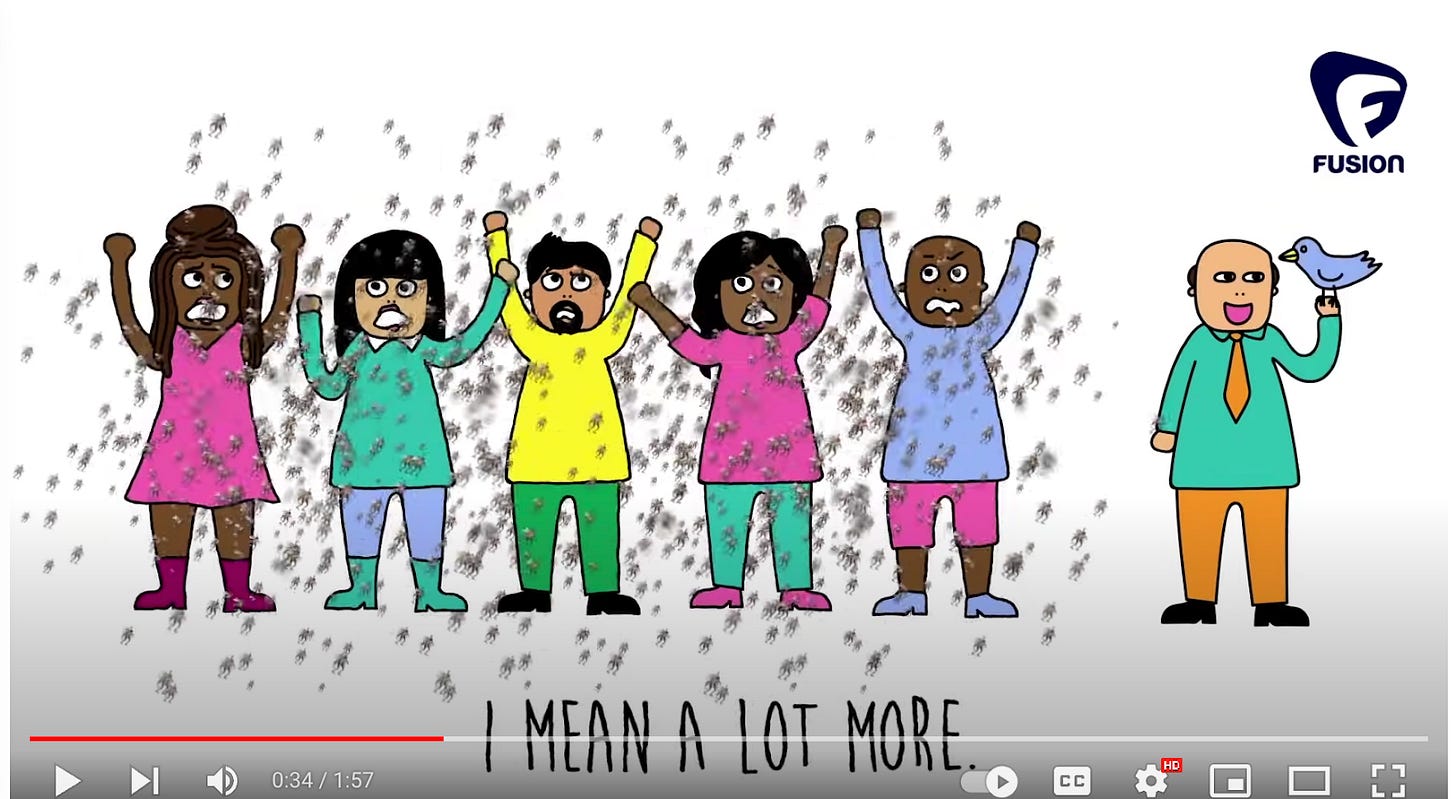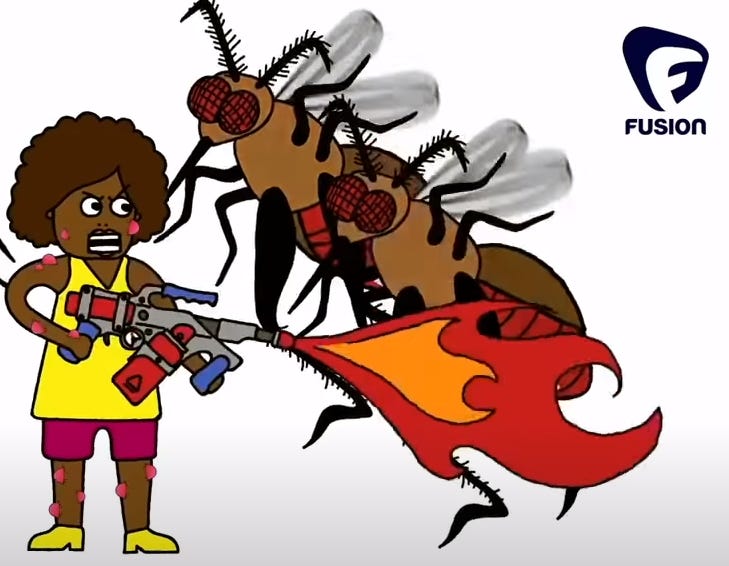Misleading Students on "Microaggressions"
A popular YouTube video portrays offenders as blood-sucking vermin
Children, and in fact humans of all ages, sometimes say things intentionally and unintentionally that hurt each other’s feelings. In the past decade, the reaction to this in progressive circles has changed dramatically. While adults remember being told that “sticks and stones may break our bones, but names will never hurt us,” children today are taught that words are violence and can cause students to literally be unsafe.
One specific manifestation of this shift is the current focus on microaggressions, usually defined as “indirect, subtle, or unintentional discrimination against members of a marginalized group,” which are part of the new lexicon being taught to children as young as eight years old in many schools. A popular video used for this purpose is “How Microaggressions Are Like Mosquito Bites,”1 created in 2016 by Fusion Comedy, a comedy channel with the tagline “Comedy that gives an F.” While this video might work as a piece of satirical humor for adults, its world-weary, patronizing tone and manipulative, often violent imagery make it entirely inappropriate for children and young adults.
The video opens, not with a definition of microaggressions but with this line: “For people who still don’t think microaggressions are a problem, just imagine, instead of being a stupid comment, a microaggression is a mosquito bite.” The image shows a white girl and a brown girl waiting at a bus stop. The white girl says “You’re so well spoken” to the brown girl. The brown girl whacks her own forehead and breathes out a visible huff of annoyance. The white girl then morphs into a human-sized mosquito. The mosquito says, “It’s a compliment,” and then bites the brown girl, its whole mosquito-abdomen filling up with the girl’s blood.
The video goes on to explain that “Mosquito bites and their itch are one of nature’s most annoying features. But if you are only bitten every once in a while, sure, it’s annoying, but it’s not that big a deal. The problem is that some people get bitten by mosquitoes a lot more than other people. I mean, a lot more.” During this narration, a row of black and brown people appear with one white person off to the side. The black and brown people are swarmed by mosquitoes while the white person, smiling obliviously and for some reason wearing a tie, holds out his hand for a blue bird to land on.
Sending the wrong messages
On its surface the video communicates that small, unintentional remarks might irritate and annoy people in a way that the speaker is unaware of. This is certainly true. But the imagery and tone of the narration also communicate the following:
1 - Speech causes physical harm. Words have the power to raise literal welts on the skin. The metaphorical framing of microaggressors as mosquitoes extends to include the corollary that insults are bites.
2 - Those who commit microaggressions toward others feed off the harm they cause in some way. It is hard to square this with the “unintentional” nature of microaggressions. Are we to believe those who commit microaggressions are doing so unintentionally oblivious to the harm done, or are we to believe they are feeding off their victims as these mosquitoes are? It can’t really be both.
3 - The world can be neatly divided into “Us vs. Them”: those who are harmed by microaggressions and those who cause the harm. When students are presented with these two choices, they want to identify as victims: No one wants to be a “bad guy.” This false binary encourages students to overly focus on their victimhood in whatever shape that comes as well as to see everyone else as either part of “their” group or part of the “other” group. “Us vs. Them” is one of the three great untruths Jonathan Haidt and Greg Lukianoff discuss in The Coddling of the American Mind. For schools hoping to build community, fostering “Us vs. Them” thinking runs counter to that.
4 - People from marginalized groups have no agency in how they react to microaggressions. In the video, there is no diversity in how those affected by microaggressions respond. Each and every one of the affected individuals has the same horrified expression that shows they have experienced great harm. No one seems to have the ability to speak up for themselves, to engage with the person who has hurt their feelings, or to ignore the microaggression and move on unscathed.
What follows is a series of quick scenes in which someone experiences a microaggression. The victims, mostly black and brown, include a man in a wheelchair being told, “Everything happens for a reason,” a woman being asked, “When are you going to have a baby?” a native person hearing someone on TV voice the opinion, “We have to keep the Redskins name,” and a gay couple being told, “I couldn’t even tell you were gay,” and, “I love Cher too!” among other things.
Justification for Violence
In one of the most problematic scenes in the video, the narrator explains that “...getting bit by mosquitoes every day multiple times a day is annoying and makes you want to go ballistic on those mosquitoes which seems like a huge overreaction to people who only get bit every once in a while.” The imagery shows a black woman being told, “You are so pretty” and being asked, “Can I touch your hair?” In response, she pulls out a large weapon and blasts all the mosquitoes to death.
It is astounding that schools choose to show this to students as it models using the most extreme type of force — something resembling a mass shooting — in response to verbal insults that may indeed have not even been ill-intentioned.
We wouldn’t teach students that if someone bumps into them in the hall by accident they should punch them in the face in retaliation. Nor should we teach students that it is ever okay to use physical violence against words. This scene also is extremely dehumanizing, equating an unintentionally hurtful remark with a person’s entire being so that those who commit microaggressions are portrayed as nothing more than the embodiment of the microaggressions themselves.
In the final scenes of the video, the narrator explains: “Of course beyond just being annoying, some mosquitoes carry truly threatening diseases that can mess up your life for years.” We see a student in a college counseling office saying that he might like to study astrophysics, while the mosquito behind the desk responds, “Hmm. Maybe you should try a less challenging major.” This is followed by a scene in which a mosquito has presumably just shot someone to death. It stands there with a gun near a chalk outline on the sidewalk and four cops. The narrator explains, “And other mosquitos carry strains that can even kill you,” while the mosquito says, “It looked like he was up to trouble. Ok? I felt threatened.” The viewer is asked to fill in quite a large gap here, but the implication is that the mosquito (a microaggression?) has just shot a black or brown person dead for no good reason and that the cops will support the mosquito/microaggressor, and not the victim.
The video ends with these lines: “So next time you think someone’s overreacting, just remember, some people experience mosquito bites all the time. And by mosquito bites we mean microaggressions.” In the final image, a row of black and brown people stand, swarmed by mosquitoes as they were in an earlier scene, but instead of a white guy in a tie off to the side, a mosquito stands in his place, telling the line of people, “You’re all so exotic!” In response, the row of black and brown people pull out fly swatters and smash the mosquito until it is just a brown puddle.
Seven Things to Teach Instead
Schools, as well as families, play a role in helping to foster kindness and empathy in children. Instead of teaching students to avoid committing—and to overreact to receiving—small, unintentional microaggressions, here are some other healthier approaches schools can take.
1. Teach students that all humans deserve kindness and respect, regardless of the color of their skin or any other immutable characteristics. Help them resist “Us vs. Them” thinking.
2. Teach students to think about the needs and desires of others. This may very well begin with the Golden Rule: “Do unto others as you would have others do unto you.” This is a great starting point in terms of ethics, but as children grow up, they can learn that it isn’t always enough. They can also take into account what the other person wants done to them. If you love vanilla ice cream, but your friend prefers chocolate ice cream, it is kinder to get them chocolate ice cream even though that is different from what you would want done “unto you.”
3. Teach students to assume good intentions and to beware the “mind-reading” cognitive distortion. Connected to the example above, we must acknowledge that we cannot read each other’s minds. Some people will feel flattered and happy to be told their hair looks pretty. Others will find it to be an annoying microaggression. The color of the person’s skin does not guarantee either reaction because each person is an individual. So when someone guesses wrong about you, don’t assume they are doing it to annoy you. Remember that they cannot read your mind, just as you cannot read theirs. Assuming the good intentions of others creates healthier relationships and communities.
4. Empower students by teaching them that words are not violence. In a recent article in Quillette, Lawrence Krauss writes that “Words have the power to incite violence, but this depends on the receptiveness in the mind of the listener. This agency on behalf of the person who is called a name or told an unpleasant remark is extraordinarily important. Krauss goes on to write, “...in a world where words are treated as if they are both weapons and attackers, and where we shield ourselves from them for fear they might induce feelings in us that we don’t like, we don’t become victors—we only further victimize ourselves.”
5. Instead of teaching students to be victims, teach them to avoid injustice mongering and grievance collecting. And specifically, don’t teach explicitly or implicitly that people of color are more sensitive or fragile than white people. They aren’t.2
6. Teach students about Antifragility: a property of systems in which they increase in capability to thrive as a result of stressors, shocks, volatility, noise, mistakes, faults, attacks, or failures. The concept and term was developed by Nassim Nicholas Taleb in his book Antifragile. The concept goes beyond that of resilience and can usefully be applied to humans and how they grow.
7. Look for models of DEI that respect all people and encourage us to be in community with each other. Examples include Sheena Mason’s Theory of Racelessness, Chloe Valdary’s Theory of Enchantment, and the Foundation Against Intolerance and Racism.
As educators, we must remain careful and mindful of the lessons we are actually imparting to the youngsters in our care. Otherwise, ironically–just like this unhelpful video suggests–we may unintentionally deliver the wrong message.
This is one of the “clean” versions available on YouTube. The original version included the words “fucking” and “goddamn” which were removed in a more palatable version. Other than that, it is the same as the original. It has almost a million views.
“Intended or not, we’re telling Black and Latino students that they’re less capable” John McWhorter - NYTimes Opinion March 15, 2022







Hmmm...Seems to me you are advocating coddling and underestimating teens when you claim that they simply could not handle this video.